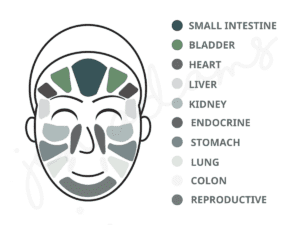Face Mapping Skin Analysis: Reveals Metabolic Health
Your face mapping skin analysis will give you clues about your metabolic health
The odd pimple, blemish and or forehead acne may seem an innocent reaction to a recent indulgence or a bout of stress, but these facial breakouts may be a warning sign of underlying metabolic health due to a poor diet of rich food or processed foods.
Acne face mapping is a traditional Chinese medicine practice that uses the face as a map to diagnose various inner health issues.
According to these ancient Chinese acne face map techniques, hormonal acne or flare ups on different parts of the face reflect specific health concerns in certain organs in the body.

What is Face Mapping Skin Analysis?
Though the principles of face mapping have changed over time, some basic concepts have remained. Nowadays, they’re rooted in more modern medicine rather than ancient Chinese medicine.
While the acne face map can provide clues about internal health, it’s important to remember that many factors can affect the skin’s surface, such as food allergies, digestive system, reproductive system, adequate sleep and stress levels. So, face mapping should be used as a guide rather than a definitive diagnosis.
However, it is still true that any acne breakout or skin blemish is often indicative of dysfunction within your metabolic pathways.
When there’s some imbalance in your body, it is likely to manifest in forehead acne flare ups, spots, redness, rash or dry patch on your skin’s surface.
As a functional nutritionist and aesthetic therapist, there is no official scientific basis for face mapping. It is however an effective practice to understand how a person’s chi flows to and from their organs as this will have an influence on the metabolic pathways.
Your skin is the body’s largest organ and is affected by three essential metabolic pathways: the gut microbiome, blood sugar levels and liver function.
Understanding our internal health and focusing on making meaningful changes to our diet and lifestyle choices when wanting to improve these skin issues is more effective than reaching for skin cream.
In this article, I want to share a general overview of the link between your metabolic health and symptoms on your skin; it is important to understand that they are clues or contributory factors from dysfunction in one or all of the three main metabolic pathways.

The three main metabolic pathways that impact your skin health are:
- Delivery of energy in your cells.
- Clearance of toxins.
- Absorption of nutrients in your gut microbiome.
Suppose there is a lack of blood sugar control, sluggish liver function and gut dysbiosis. Your skin will struggle with congestion, blemishes, dryness or flaky skin.
Using the traditional form of face mapping, the areas of congestion and blemishes are a great way to identify which part of your metabolic health influences your skin cell membrane health and impacts the signs of ageing on your skin.
What causes my blemishes on the skin?
When discussing blemishes on your skin regarding face mapping, it refers to the build-up of dead skin cells, sweat and sebum in the pores, leading to blackheads, large pores and uneven skin texture.
If the pores become blocked, they can swell and become inflamed, leading to blemishes such as pimples, whiteheads or cysts.
The three main causes of blemishes on ANY area of your skin;
- Poor gut health
- Hormonal imbalance
- Sluggish liver function
Why does poor gut health affect my skin?
The gut microbiome plays a significant role in skin health as it is home to 70% of your immune system.
Food intolerances trigger an immune reaction which in turn stimulates the inflammatory response.
An unhealthy gut microbiome leads to an increase in harmful bacteria and a decrease in good bacteria. This imbalance is known as dysbiosis.
Dysbiosis has been linked to various skin conditions, such as blemishes, acne breakouts, and pimples on the skin.
But when the gut dysbiosis leads to a leaky gut and becomes inflamed, the consequence can show up on the skin as dry, itchy and flaky skin. This is due to the lack of absorption of essential nutrients required to create the skin cell membrane.
Poor digestion leads to skin conditions such as eczema and psoriasis.
How do hormonal imbalances affect my skin?
Hormonal imbalances are one of the most common causes of outbreaks of blemishes, clogged pores, or cheek acne on the skin. When there is an imbalance in the blood sugar and reproduction hormones, this can lead to an over-production of sebum, which can be challenging to manage and hence clogs the pores and blemishes.
How does a sluggish liver function cause oily skin?
The liver’s primary role is to clear out toxins and help your body absorb nutrients from the rich foods you’ve eaten. When overloaded, your liver will excrete the excessive toxins through your skin cells.
To do this, the skin creates more sebum to transport the toxins through sebaceous oil glands. The excess sebaceous gland activity acclimates around the T-zone [main lymph drainage point], causing the skin to adapt and create big open pores to hold more sebum.
Excess oil production in the T-zone may result in dry skin on parts of the face, creating a dehydrated appearance. This will cause overactive sebaceous glands to produce more oil in an attempt to control greasy skin, which can lead to an increase in blemishes, oily skin and acne.
What causes pimples on the forehead?
If you’re experiencing small pimples on your forehead between your eyebrow, this is an indication of small intestine dysbiosis.
In that case, this points to issues with the gut microbiome in particular the pH levels in your small intestine.
Forehead pimples are often caused by an inflammatory response to gluten and dairy intolerances, creating a gut flora imbalance due to higher pH levels in your food.
When you have a gut flora pH imbalance, this increases the risk of inflammation in the tight junctions of your skin cells which creates an autoimmune response to the leaking of the food out of the gut into the bloodstream.
The most common foods are lactose, the natural sugar present in milk products, and gluten, the protein in the flour found in most bread, biscuits, cakes and pizza bases.
What causes elevens between my eyebrows?
Deep wrinkles or frown lines are often assumed to be because you frown too much, but they can also be caused by glycation, creating advanced glycation end products known as AGE.
When AGEs are formed within the skin, you may see deep wrinkles appearing on your face.
AGEs are the contributing factors that cause the cross-linking of collagen and elastin fibres, which results in a loss of skin elasticity and suppleness, which are indications that your liver is struggling with too much alcohol, signs of dehydration and lack of blood sugar control.
What Causes Crow’s feet to be so bad?
Crow’s feet indicate that your kidney’s function is struggling with clearing the pollutants in rich food and beverages, which can accumulate in tissues as a result of reduced lymph flow throughout the body.
This can cause the eyes to become puffy and the formation of fine lines and wrinkles due to dehydration, which can also cause the skin to lose elasticity.
Why do I have pimples on my cheeks form in times of stress?
Pimples around the cheekbone, temple area and jawline acne are often a result of your body trying to manage the production of stress hormone levels of cortisol, insulin and glucagon.
Stress can be caused by the quality and quantity of food you eat and your reaction to physical or mental stress.
When you’re stressed, your body produces the hormone cortisol, which can increase the production of insulin or glucagon as it tries to deal with the lack of sleep, increased blood sugars and allergic reaction to food allergies.
The imbalance of stress and reproduction hormones creates an ideal condition for the overgrowth of harmful bacteria. It causes an imbalance in the skin microbiome resulting in cheek breakouts.
This can lead to an over-production of sebum due to the increase in androgen hormones, which can cause an overproduction of sebum on the skin and lead to an overgrowth of bacteria, which can then cause blemishes on the skin.
Why do I have a big spot on the chin?
If you have a giant, red pimple on your chin, it may be due to an overactive thyroid gland. This is a clue your endocrine system is struggling to balance your reproductive hormones.
More often, cortisol, thyroxine and estrogen will impact the creation of blemishes around the chin area, often resulting in the build-up of skin cells seen as thick skin, dimples or orange peel effect on the skin.
How can I improve my skin health?
If you find yourself suffering from a number of these skin concerns I have mentioned, it is incredibly likely that you are suffering from poor metabolic health.
To find more about the signs and symptoms of poor metabolic health read this article – Poor Metabolic Health
This means that it is time for you to start thinking about how you can make meaningful changes to your diet and lifestyle to get your metabolic health back on track rather than choosing topical treatments or covering them up with make-up.
In summary, your metabolic pathways directly impact your skin health.
Your skin is often trying to tell you which part of your body is struggling. It can be either your gut health, hormonal fluctuations, or liver function.
But more often, the underlying causes are all three. Your skin is sending you clues to focus your efforts on your metabolic health in relation to your nutrition and lifestyle choices, rather than looking for a face cream to match your skin type.
To conclude, your skin is giving you clues about your internal health. By using the traditional form of face mapping, the areas of congestion and blemishes are a great way to identify which part of your metabolic health influences your skin cell membrane health and impacts the signs of ageing on your skin.
For example, if you’re experiencing small pimples on your forehead between your eyebrow, this is an indication of small intestine dysbiosis.
Large open pores on your forehead are an indication of sluggish liver function as it isn’t able to properly detoxify your blood.
That big boil on your chin gives us a clue of an overactive thyroid gland due to your endocrine system struggling to balance your reproductive hormones.
So, if you’re struggling with any skin blemishes, this is a sign that your metabolic health is out of balance.